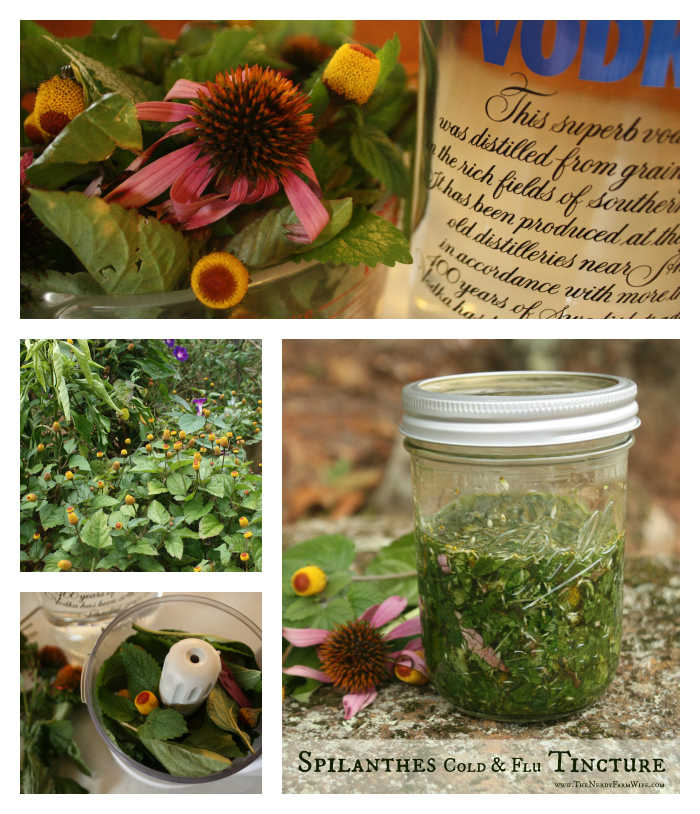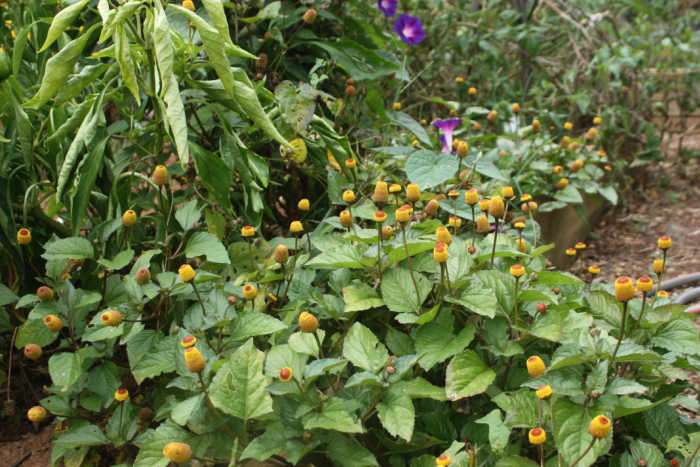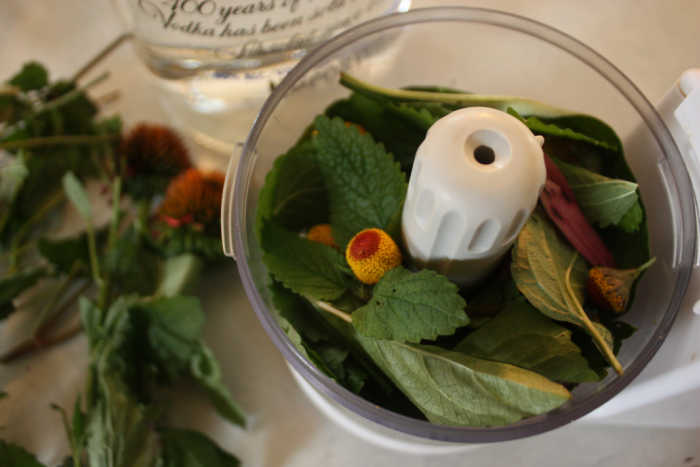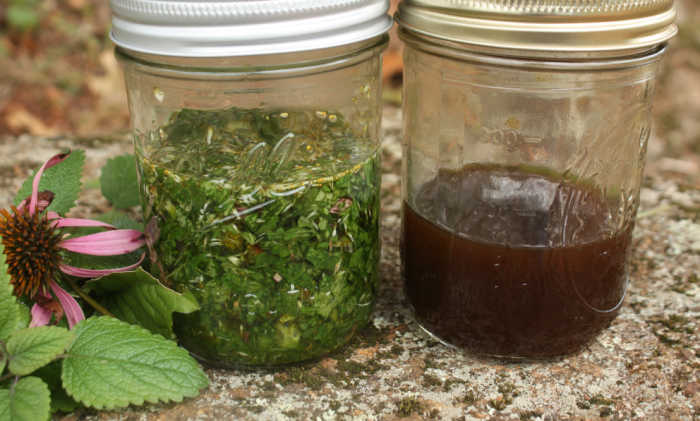My Favorite Cold & Flu Tincture
Everyone has their favorite way to prevent and treat colds and the flu; today, I’ll share mine with you!
It’s a simple little cold and flu tincture that I grab whenever someone says they are feeling icky. I also dose it out when we’ve been around crowds or people that are coughing or showing other signs of illness. (So, basically most holiday gatherings.)
If you take it quickly enough, more often than not, you’ll wipe out the illness and won’t have to follow up with other home remedies to treat the symptoms.
I love this stuff so much, that if I were thrown in the midst of a flu epidemic and could only take two things with me – one would be my Spilanthes Cold & Flu Tincture. (The other would be Sambucol – an elderberry extract.) It’s that effective in keeping us healthy for the majority of flu season.
I grow all of these plants in my garden, but you can find echinacea and lemon balm (melissa) at Mountain Rose Herbs. The only herb difficult to obtain dried or fresh may be Spilanthes (also known as “toothache plant”), but you can buy the ready made Herb Pharm tincture at Amazon.com and either combine with the others you make/buy OR use it on its own. It really is the star of this mixture, after all!
Spilanthes is also super easy to grow from seed – I planted it one year and it keeps coming back and spreading with absolutely no effort needed on my part.
You can buy the seeds from Strictly Medicinal. I really encourage homesteaders and prepper-types to try to grow this plant, if at all possible. You never know when it might be critical to grow your own medicine!
I first grew interested in Spilanthes when I was researching natural ways to combat the high levels of bad bacteria my son had (including chronic strep.) He was on antibiotics, vitamins, minerals, probiotics, special immuno-things that cost a fortune, you name it!
In vitro testing has shown Spilanthes effective against E.coli, pseudomonas, salmonella, klebsiella pneumonae, staphylococcus albus, and candida albicans. It is also used traditionally as a malaria treatment & for gum infections. It seemed to me, that it would be great to add to our arsenal in the fight for his health.
The only caveat to note is that it is indiscriminate about which bacteria it wipes out. It’s fine to use as a mouth rinse more frequently for gum infections, but you won’t want to ingest it daily for too many days in a row, so that you don’t inadvertently deplete your good bacteria too. Probiotics and yogurt consumption can help offset this trait.
I often find that just one or two doses is enough, if taken soon enough after symptoms start, so this has never been an issue for us.
Spilanthes Cold & Flu Tincture
- handful of lemon balm/melissa leaves (anti-viral)
- handful of echinacea leaves and/or flower petals (immune-boosting)
- handful of spilanthes flowers and leaves (the buds have the most active constituents, so try to use as many of those as possible)
- vodka (80 proof or higher)
To make a tincture from fresh plant matter, place the leaves, flowers, and/or stems that you wish to use into a small mini-food processor. I got this one fourteen years ago, as a baby shower gift and have used it a ton for so many different things – and it’s still going strong! A favorite household appliance for sure!
Add just enough vodka (80 proof or higher) to moisten and process until a coarse texture is obtained. Spoon the macerated herbs into a sterilized glass jar, pour in more vodka until covered, cap and store in a cool, dark place for 4 to 6 weeks before straining and storing. (Try to remember to shake periodically while the herbs are still in the alcohol- I sometimes forget, but it’s a good thing to do!)
Above, I posted a picture of freshly made tincture, on the left, next to last year’s tincture (which is still good and perfectly fine to use.) It’s normal for it to turn brown after some time has passed.
For my husband and myself, I mix one-half dropperful with a spoonful of honey and/or mix a half to whole dropperful into a glass of ginger ale if we feel queasy.
Use half as much for kids – usually I use around three to five drops for them, unless they have upset stomach symptoms, then I use more. We often don’t need a second dose, but if needed, you can dose again an hour or so later, then every couple hours thereafter until you’re feeling better.
Remember not to use continuously for too many days in a row, so that you don’t deplete the good bacteria in your gut while killing the bad guy germs.
As a mouthwash, for sore or inflamed gums, put a dropperful in a glass of water and swish and spit with it a few times a day until the problem is cleared up. Remember, serious signs of infection warrants a visit to a qualified physician, naturopath, or dentist.
So, there’s my favorite way to stay healthy in the winter! I hope this post encourages a few more people to grow spilanthes – it’s an amazing herb that I hope is utilized more in the future!
This is a home remedy for symptoms of the common cold and flu. For serious illness, questions or concerns, or if you start feeling worse, please consult your family health care provider for advice and/or treatment.







Can your favorite flu remedy be concocted without the vodka?
Thankful for your informative posts, and the beautiful pictures of your products.
Hi Ann! You could possibly try making a fresh, strong decoction or tea of the herbs with hot water and a generous amount of honey on an as-needed-basis. I’m not sure how water-soluble the active constituents of spilanthes is, but since you can chew on the leaves (sparingly, they numb the mouth and make you drool a lot!) then I wouldn’t see where it would hurt to try! Lemon balm tea is absolutely lovely and something I used by itself a lot, before I discovered spilanthes!
Hello Ann, I had another thought – these herbs may be suitable for making a medicinal vinegar. In that case, you would use apple cider vinegar instead of vodka and allow to set for 2 weeks before straining. The shelf life would be shorter, and you may want to store in the refrigerator. That’s the topic of a post I want to write soon – before distilled liquor came around, vinegar or wine was often used in herbal remedies and it may be useful still for those wishing to avoid alcohol.
spilanthes can be found at most Amish Produce and plant stands in their communities. I by almost all of my herbs from them for 2 reasons, I know what is used on them and how they are grown and many are heirloom seeds that they have harvested themselves. Besides they are awesome people to deal with and have a well of knowledge.
Thanks for the tips Pati! That’s wonderful to live by an Amish community. I agree, they are a great group of people we can learn a lot from!
You could also try food grade glycerin . Its not as strong and you won’t see the fever reducer that is in alcohol but safer on kids.
I was wondering what I could do for staphlococcus aureus. I got it in 2007 with a total knee. I’m still fighting it, I’m overweight now and I’m afraid to lose it, I lost a bunch of weight and I was so sick I thought I was going to die. I do use herbs and respond best to natural medicine. I was on 20,000,000 units of penicillin a day for the staph with a PICC line. Any suggestions here, I figure it can’t hurt to ask.
Wow, I’m sorry you’ve had to go through all of that! I worked with both a naturopath and a physician who was open to alternative medicine (a rarity, I know!) and they helped guide me on which herbs would safely go with the medications my son was on plus he had to be on a special diet – the Specific Carbohydrate Diet. It’s definitely a balancing act and it took the course of a few years to slowly accomplish his particular case of healing. If you have any type of naturopath near you or even a town or two over, it’s worth the time to consult with one. I hope you feel better!!
Pam, Sorry to hear you are infected with MRSA. My sister and I both contracted MRSA while caring for our father, who got it from the hospital. During this time we discovered colloidal silver helped keep his at bay by cleansing daily the affected several times a day. When he returned to the hospital the doctor was surprised how good his wound looked and asked what we had done. When we told her she let us know that they had a colloidal silver cream. We often wondered why they did not share with us. Or use it to help him. Any way, if you have an open site it is good to use. But usually it stays at rest. It will always be in your system.
Tea tree oil is another followed by Vit E once its closed to keep down scaring and aid in healing.
Thanks for the recipe! I also have echinacea and lemon balm, but have never heard of spilanthes. Great info!
Hello from livininthegreen.blogspot.com
Thanks Nancy! I LOVE Spilanthes – hope to spread some awareness of its benefits to home herbalists! :)
Do the herbs have to be fresh, or can this be made with dried?
Hi Lisa, You can use dried herbs. Also, I often mix dried and fresh together – depending on what I have on hand/growing in the garden.
Thank you for linking up with the Clever Chicks Blog hop this week, cold and flu season is just around the corner and this will come in handy, I’m sure!
Cheers,
Kathy
The Chicken Chick
Thanks Kathy! :) Definitely getting all prepped for it!
Thanks for the recipe. My tried and true one is the hot toddy, came from my English grandma. lol Visiting from the blog hop.
Hot toddies sound perfect for a cold too! :D
This looks great!
Thanks Amanda! :)
You’re absolutely right about not knowing when we might have to make our own medicines. Just until recent history, did people in the medical field, start using the stuff we buy too much of from drug stores, etc., and our best source of information, sadly, are grand parents and great parents, so I’d suggest someone try to visit as many older people who grew up in the country, and had no choice most of the time but to use home made remedies, to share with you their knowledge, and write a book. I used to be big into herbs, tinctures, teas, whatever was needed for several years while I lived pretty much in the middle of Charlotte. One thing I especially liked reading the post, was that you suggested using honey as a sweetener, but use local honey if you have a choice. I helps with seasonal allergies(it even goes great on a peanut butter sandwich, on whole wheat bread o’ course) lol
Hi Chuck!
I agree, our grandparents are such a treasured source of information. I learned so much of what I know about plants and gardening from my husband’s grandpa – we just don’t treasure that enough while they’re still here with us! And yes, local honey is best! :)
Hi Jan! I’m loving learning about the Spilanthes!
Stupid question here… I did read your previous response to Ann… but I was wondering if the alcohol could possibly be “cooked out”, or if it dissipates or anything. (lol, I obviously know next to nothing about alcohol. I just avoid it..)
I’ll probably try the vinegar method with this, but I was curious. :-)
Hi Susie! :) Definitely not a stupid question! I had the same concern when I first started dosing my kids with tinctures purchased from the health food store. You can gently heat an alcohol based tincture for a short while and the majority of the alcohol will evaporate out. So, say you have a steaming hot cup of tea or coffee or hot cocoa: just add the tincture (for my kids I literally dose something like 3 to 5 drops at a time) and leave it uncovered for a few minutes. The herbs stay, a lot of the alcohol goes. Personally, I don’t drink and no one in my family does, so I avoid it too, other than medicinal use – but the amount in a tincture dose (since it is so concentrate, you use very little) is not really much different than the old style cough medicines that had alcohol as an ingredient. (well, “old” style as in the ones my mom gave me when I was a kid haha)
Ok, thanks Jan! I remember those cough medicines! lol
This probably doesn’t have any more alcohol in it that vanilla extract, huh? :-)
Yep, same as vanilla extract. :)
Yes, same as vanilla extract, and for the same reason. This is an old method of extracting flavour, colour, or medically useful elements from plants. Our bodies can metabolise small amounts of alcohol, it occurs naturally in our food; sometimes you see birds drunk from eating fermented berries. Some is even made inside of our bodies. Yeast is literally everywhere, especially on our skin. Anywhere it encounters food without oxygen, you have ethanol.
I am curious if you can substitute Echinacea with something else. I am very allergic to coneflowers and have had serious allergic reactions to it in the past. I use an Elderberry tincture currently when we have any cold symptoms. Thanks in advance! :)
Hi Jessica, You could just leave the echinacea out. I make and love this combo, but I also make individual tinctures of each kind too. Spilanthes tincture is used for a sore tooth rinse or for tummy aches, lemon balm is great by itself to take if you’ve been around sick people and would like to try to head off catching anything. You really have lots of options! :) Elderberry tincture is wonderful by itself or in combination with other herbs. You can mix and match anti-virals to suit your tastes/allergies. A few other ideas off the top of my head would be ginger, hyssop, licorice… (Just look up each one and make sure that it’s not in the same family or has warnings against any other health conditions you have.) Happy experimenting! :)
Thanks for the info, so helpful. I can’t believe I’ve never come across this herb before in my readings.
That is a very interesting article – I hadn’t seen that one. Thanks for sharing!
Hello Jan!
I had a question concerning the outcome of your sons bacteria count after using Spilanthes to combat it. Was there a significant difference? I am only curious because my brother has the same problem with strep and we h e found out that strep can live in your gut; killing your good bacteria and throwing things out of whack. As of right now he is on string antibiotics to kill the strep and other bad bacteria harboring in his body, as well as, a strong probiotic to replenish his good guys. Thank you for this article by the way! I shared it with my mother, because we are very much into doing things the natural way. Have a great day! Many blessings to you and yours!
Hi Cassandra! At that time, we used spilanthes along with a lot of other things, and that was one of the later things I tried when he was already on the way to getting better, so I’m not sure of the many, which was more effective. He was also on some heavy duty antibiotics like vancomycin and flagyl at one point. (Though all they seemed to do, was make him sicker.) What really made the biggest difference was the Specific Carbohydrate Diet along with food enzymes (Houston brand, though now we take Nature’s Sunshine) and heavy duty probiotics (Natren – Healthy Trinity & Gastro-pH). The doctor tested by strep titers, which were so high that we got denied insurance at one point, but finally went down to normal. (That was a happy day!) :) He did have some initial tests (stool, urine) showing high markers for bacteria too & had some c. diff problems, but he healed up so nicely, we never did follow ups for those. I was extremely resistant to the diet, the doctor had to guilt me into trying it, but I would have to say that it made the biggest key difference, more than any other treatment. It wasn’t a quick fix though, it took a few years to get his body straight. She also felt like he was being exposed to a strep carrier at school, so we homeschooled the next year & kept him home from almost everything. That may have played a part too, but he’s been around plenty of other kids since those days (I guess about 7 or so years now) and has yet to have a relapse. I had also read about a mom that asked her doctor for Keflex to treat her son’s chronic strep. I figured, why not ask? So, even though his doctor was skeptical, she prescribed some and after two rounds, those were the very last antibiotics he had to take. So, that could have been a factor too! Back to the diet, I am 100% positive that it cleared up his asthma as well as stomach issues. The problem with his gut was undigested starch feeding the bad bacteria, so no matter what treatments we threw at them, trying to eliminate them, they were still thriving on his high starch, gluten free diet. (Research biofilms for some interesting information on how they can thrive.) I can’t recommend a trial of the SCD highly enough; it was a life changer. I sure hope that your brother feels better soon; I know it’s a tough thing to go through!
I was wondering how much spilanthes liquid extract to use when making this tincture. I couldn’t find any fresh spilanthes so I bought the Herb Pharm product mentioned above. I have echinacea and lemon balm that I grew in my garden. Can’t wait to try to grow spilanthes next year.
Also, how long should the tincture “cure” before using? Is it ready when you strain it after 6 weeks?
Hi Mamatripp! If you bought the tincture separate, I would just keep it that way. Spilanthes is so wonderful to pull out when someone is feeling a bit icky – you can just add a few drops of tincture into a spoonful of raw honey. These days, I often stir a pinch of powdered ginger (just regular kitchen spice) into that mixture too. The echinacea & lemon balm are excellent to have on hand, and you can add drops of those into the mixture as well, but they tend to be a little milder where spilanthes is a powerhouse. You can use your tincture after 4 to 6 weeks, but if needed, I’ve used it even sooner (2 weeks or so). Six weeks will yield a stronger product though.
You need to change your name to the AMAZING HOUSEWIFE! I have lived in an old farm house (circa 1865) for over 20 years. It came with 2 acres which I found is great for growing herbs. I like how they can come back year after year with a vengeance. With that said I needed to find ways to use them. Your website is the best I have found.
Thank you for sharing your information so graciously.
Hi Donna, thank you so much for the kind words! I’m so happy that you find the site useful!
are fresh herbs necessary or can we use dried? I order a lot from bull herb store and do not garden so only have dried…
Hi Julie! Bulk Herb Store is great – everything I’ve gotten from them has been high quality and fresh, so dried herbs from them would make for wonderful tinctures too.
Hi- I checked out the Horizon Herbs link you had and they have two varieties of Spilanthes, both with different botanical names. The fist is listed as “Spilanthes, Brede mafane (Acemella alba)” and says it’s toothache plant, and the second listed is “Spilanthes, Official*, Acemella oleracea” and also calls it toothache plant.
Which one is the right one?
thanks
Hi Paula! I use Spilanthese, Official, Acemella oleracea.
Would love to try this-where could I find the spilanthes flowers? I looked on MRH but they just had the extract and seeds :(
Hi Karen! I’ve seen dried spilanthes at Jean’s Greens before. I’ve ordered different herbs from there before and have been pleased with the quality!